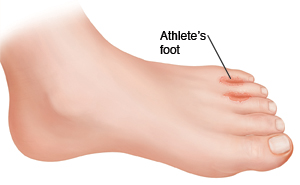Athlete’s foot (tinea pedis) is caused by a fungal infection in the skin. It's sometimes called ringworm even though a worm doesn't cause the infection. Athlete’s foot affects the skin between the toes, causing cracks in the skin called fissures. It can also affect the bottom of the foot where it causes dry white scales and peeling of the skin. This infection is more likely to occur when the foot is in hot, sweaty socks and shoes for long periods of time. You may feel itching and burning between your toes. This infection is treated with skin creams or medicine taken by mouth.
Home care
The following are general care guidelines:
-
It's important to keep the feet dry. Use absorbent cotton socks and change them if they become sweaty. Or wear an open-toe shoe or sandal.
-
Wash the feet at least once a day with soap and water, and dry them well.
-
If your health care provider prescribed an antifungal medicine, use it as prescribed.
-
Some antifungal creams are available without a prescription. Follow the instructions on the medicine package.
-
It may take 1 week before the rash starts to improve. It can take about 3 to 4 weeks to completely clear. Continue the medicine until the rash is all gone.
-
Use over-the-counter antifungal powders or sprays on your feet after exposure to high-risk environments, such as public showers, gyms, swimming pools, and locker rooms. This can help prevent future infections. Wearing appropriate shoes or sandals in these situations can help.
Prevention
These tips may help prevent athlete’s foot:
-
Don't share shoes, socks, towels, or sports equipment with someone who has athlete's foot.
-
Don't walk barefoot in places where a fungal infection can spread quickly, such as locker rooms, showers, gyms, and swimming pools.
-
Change your socks regularly. Don't wear the same socks for more than 1 day.
-
Alternate shoes to help with drying, or wear shoes that allow airflow.
-
Dry your feet well after swimming or bathing.
Follow-up care
Follow up with your provider as advised if the rash doesn't improve after 10 days of treatment, or if the rash continues to spread.
When to contact your doctor
Contact your provider right away if:
-
You have a fever of 100.4°F (38°C) or higher, or as directed by your provider.
-
Redness or swelling of the foot increases.
-
The infection comes back soon after treatment.
-
Pus drains from cracks in the skin.


